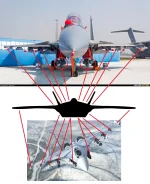News Columnist
- Messages
- 555
- Reactions
- 12
- Points
- 18
India's Fighter Jet Dilemma: Does AMCA Signal the End of the MRFA?
The Indian government's recent green light for the ambitious Advanced Medium Combat Aircraft (AMCA) program has sparked renewed debate about the long-delayed Multi-Role Fighter Aircraft (MRFA) tender.This tender aims to procure 114 fighter jets from foreign manufacturers. Despite mounting pressure to abandon the MRFA in favor of indigenous production, sources close to the program suggest that scrapping the tender remains unlikely.
The MRFA: A Protracted Process
The MRFA tender, designed to bolster India's dwindling fighter squadrons, has drawn interest from global aerospace giants. Each offers advanced aircraft to fulfill the Indian Air Force's (IAF) needs.Yet, the tender's progress has been frustratingly slow. It remains stalled at the pre-Acceptance of Necessity (AoN) stage, leaving the IAF with a troubling shortage of fighter jets while domestic options like the AMCA and Tejas MkII remain under development.
The IAF strongly backs the MRFA's plan for 114 jets to be built in India with technology transfers. But the lack of a finalized deal signals a potentially lengthy journey to completion.
Alternative Paths: Government-to-Government Deals
Amid this bureaucratic tangle, India's government isn't ruling out alternatives, specifically government-to-government (G2G) purchases.This route could see India acquiring fighters directly from a favored manufacturer, like Dassault Aviation and its Rafale aircraft.
A G2G deal could significantly speed up procurement, providing the IAF with much-needed reinforcements.
AMCA: The Future vs. The Urgent Need
The AMCA represents India's bold technological leap towards defence self-sufficiency. However, the IAF's urgent operational requirements must also be met. Calls to cancel the MRFA and focus entirely on domestic production ignore this immediate crisis.A G2G deal needs careful analysis. India must balance cost, the fighter's capabilities compared to other MRFA contenders, and how it dovetails with India's long-term defence goals. The choice must prioritize combat effectiveness, dependable support, and affordability.
Conclusion
The AMCA's approval highlights India's determination to build its own cutting-edge defence technology. Yet, the MRFA tender's uncertainty and the IAF's dwindling combat power create a complex dilemma.The Indian government must navigate a delicate path, balancing future aspirations with the immediate necessity to bolster its air power. The final decision will have far-reaching implications for the IAF's capabilities and India's defence industry.

